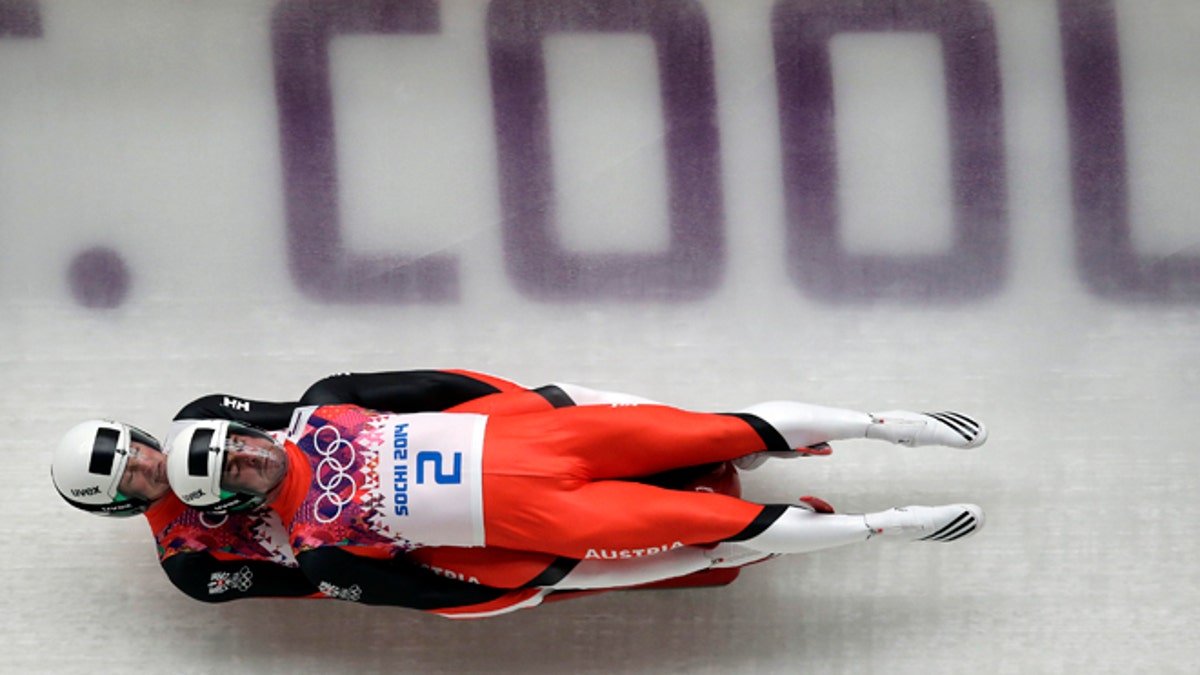
Feb. 12, 2014: The doubles team of Andreas Linger and Wolfgang Linger of Austria speed down the track in their final run during the men's doubles luge at the 2014 Winter Olympics. (AP Photo/Michael Sohn)
KRASNAYA POLYANA, Russia – Nineteen-year-old Slovakian luger Josef Petrulak competed in the Sochi Olympics in a 22-year-old sled. That's right: His sled is three years older than he is. His German rivals get a new sled every year, designed by BMW and calibrated to whoosh faster, smoother and smarter every season.
It's not hard to guess who won the doubles gold at the Winter Games this week.
Much as we'd like to, no one today can pretend that the Olympics — or any sport, for that matter — is just about exceptional physical ability anymore. It's about the marriage between exceptional humans and exceptional technology, a union in which technology is increasingly the breadwinner.
Every advance in the ever-accelerating juggernaut of sports technology threatens to widen the divide between Olympic haves and have-nots. Well-sponsored teams and rich governments pay top-end scientists and engineers to shape their skis, perfect their skates, tighten their suits, measure their gravitational pull. That brings home medals, which in turn brings home new attention, new sponsors, new money to invest for the next race.
"Absolutely every little thing you can do counts, when a sport measures to the 1,000th of a second," says American luger luge. "The suit, the shoes, the helmet, good position, aerodynamics, everything."
The tech factor goes all the way down to the wax used by Olympic skiers — 500 different wax products to choose from, and special technicians to apply them.
The U.S. luge team, less well-funded than more popular sports like snowboarding and without the government funding that some other countries' teams enjoy, had been falling behind in luge before BMW and Dow Chemical stepped in with money and expertise.
Ferrari infuses money and research to Italy's speedskating, bobsled and luge teams. Britain's skeleton team gets money and advice on aerodynamics from Formula 1 giant McLaren.
To keep things from getting too skewed toward corporate connections, sports federations and Olympic officials try to level the field.
— The International Olympic Committee takes poorer athletes under its wing and supplies them with more cutting-edge equipment.
— The International Ski Federation banned parabolic skis that turn too sharply, to the indignation of U.S. skier Ted Ligety.
— A new ski jump monitoring system uses algorithms to take Mother Nature out of the equation, factoring in wind speed and direction for each skier to create a fairer result "The athlete's performance is taken out from the influence of external conditions. So it's purely athletes' performance," said Walter Hofer, ski jumping competition director for the International Ski Federation.
Sometimes technology works to everyone's advantage, or is meant to. Advances in camera abilities at these Olympics are allowing much closer, clearer and faster footage that athletes can later study to improve performance.
Underequipped underdogs still have a chance; Jamaican sprinter Usain Bolt started out as an IOC aid recipient. When they do overcome the odds and rivals' superior technology, those victories are more special than ever.
But no Olympic athlete today is technology-free. Even if they shun banned substances, the medical treatment they receive can border on bionic.
It's hard to find anyone who wants to turn the clock back to the days of wooden skis and pre-Zamboni ice rinks, despite a perception that the Olympics were more about pure sport back when athletes carried their own equipment in the opening ceremony of the first Winter Games 90 years ago.
"Look at my son. He's 4 and he knows how to use the iPad better than I do. He creates folders, things I don't understand. Technology is life today," said Russian fan Alexander Bykovsky. He and his family marveled at the wonder of watching ski jumpers and lugers in person, even if his camera wasn't fast enough to catch their action.
Skier Ligety argues that efforts to hold athletes back run counter to progress. The ski federation's decision to ban parabolic skis "was a wrong decision as far as the progression of the sport, and as far as safety goes," he told reporters this week.
Still, he had the time and money to prepare for competition back on skis with less of an hourglass shape. "I was able to work with my ski company really closely in order to develop a lot of prototypes to figure out how to make the best skis."
The Slovak team with the 22-year-old sled doesn't enjoy that kind of luxury. But they're not bitter. Asked whether it's unfair that teams with newer sleds won Wednesday night's men's double, Petrulak said: "In principle, yes."
But he noted that skill and teamwork count, too. If the athletes aren't at their best, even top technology isn't enough. "Everything," he says, "is important."
___
AP sports writers John Leicester, Tim Reynolds and Howard Fendrich contributed to this report.